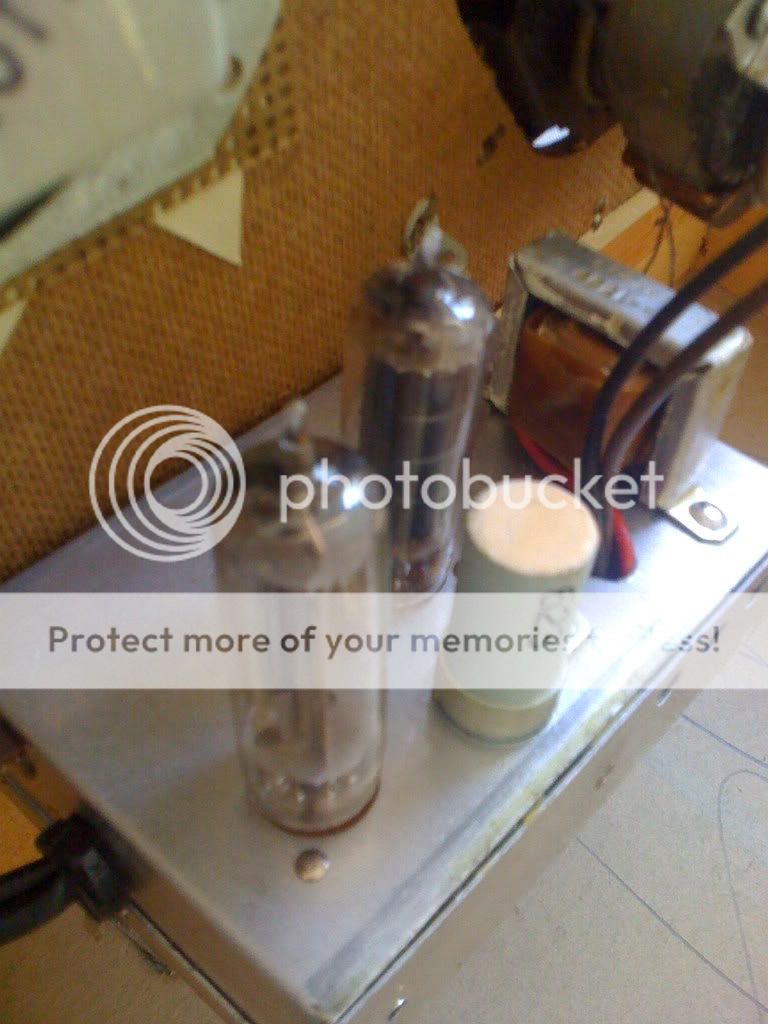Hey, guys. I have a vinyl player from the '40's. I'm not sure if these are the original tubes or not. But, I managed to draw up this schematic. Excuse the amateurism. I don't know how to draw schematics well.
Also, there's one part that I don't know what it is (you guys probably will.) It's a white cylinder that comes out with the tubes. It has "200" with "623" under it. Is it a capacitor?
Anyway, here's the schematic. Since it's not an electronic, I uploaded it to photobucket so it should be adequate size. The "white cylinder" under question is not labeled in the drawing. But it's right under "R5" which ultimately goes to the motor.
http://img.photobucket.com/albums/v714/TwistedShot/DSCF0384.jpg
The tube on the left is a 50C5, the tube on the right is 35W4. I researched the 50C5, and It has a ridiculous THD. Like 10% at .5 watts and 30% at ~1.75 watts.
Also, being a noobie, I'm always curious. Is this a pre-amp that uses the transformer as a step-up to increase the volume?
Also, there's one part that I don't know what it is (you guys probably will.) It's a white cylinder that comes out with the tubes. It has "200" with "623" under it. Is it a capacitor?
Anyway, here's the schematic. Since it's not an electronic, I uploaded it to photobucket so it should be adequate size. The "white cylinder" under question is not labeled in the drawing. But it's right under "R5" which ultimately goes to the motor.
http://img.photobucket.com/albums/v714/TwistedShot/DSCF0384.jpg
The tube on the left is a 50C5, the tube on the right is 35W4. I researched the 50C5, and It has a ridiculous THD. Like 10% at .5 watts and 30% at ~1.75 watts.
Also, being a noobie, I'm always curious. Is this a pre-amp that uses the transformer as a step-up to increase the volume?
wow, a classic.
As this is "an antique" and an endangered part of our heritage I would suggest caution before modifying.
A good restoration that returns the unit to working order is valuable, but the history of the discarded parts is lost.
Whatever you do, document your work. This may be the only one left?!?
P.S. large white cylinder with two (mebbe more) wires is probably a capacitor. Any lettering/numbers?
Transformers transform the high voltage low current domain of tubes to the low voltage, high current world of speakers.
P.P.S Pictures PLEASE!
As this is "an antique" and an endangered part of our heritage I would suggest caution before modifying.
A good restoration that returns the unit to working order is valuable, but the history of the discarded parts is lost.
Whatever you do, document your work. This may be the only one left?!?
P.S. large white cylinder with two (mebbe more) wires is probably a capacitor. Any lettering/numbers?
Transformers transform the high voltage low current domain of tubes to the low voltage, high current world of speakers.
P.P.S Pictures PLEASE!
Iain McNeill said:wow, a classic.
As this is "an antique" and an endangered part of our heritage I would suggest caution before modifying.
A good restoration that returns the unit to working order is valuable, but the history of the discarded parts is lost.
Whatever you do, document your work. This may be the only one left?!?
P.S. large white cylinder with two (mebbe more) wires is probably a capacitor. Any lettering/numbers?
Transformers transform the high voltage low current domain of tubes to the low voltage, high current world of speakers.
P.P.S Pictures PLEASE!
How could I have forgotten the pictures?
My bad.
The unit works, don't get me wrong. It's just not really good sound quality.
And I said in the OP (I believe) the cylinder says "200/623"
Here's the full thing:

Here's a picture of the archaic speaker. I have never seen a magnet like that before. And it's nominal at .5 ohms, which I found really odd being only familiar with 4 and 8-ohm drivers. The oddest I've seen was a 3-ohm one:

The amp's casing and what not:

Here's a picture of the 'Amp Layout' which is found on the bottom of the inside of the case:

And my favorite picture, the amp on at night. I love night shots of tube amps.

jerluwoo said:Naw the 50c5 isn't that bad. 10% distortion at 2.3 watts into 2.5k load.
With this chart I have, I have, it says 1.9 watts @ 2.5 KOhms @ about 38.5% THD.
Try this datasheet from rca. http://www.pmillett.com/tubedata/HB-3/Receiving_Tubes_Part_2/50C5.PDF
jerluwoo said:Try this datasheet from rca. http://www.pmillett.com/tubedata/HB-3/Receiving_Tubes_Part_2/50C5.PDF
Now I'm just embarrassed. I was reading the chart wrong. I'm sorry. You're right, 10% at 1.9 watts.
It's still pretty bad, considering that a lot of audiophiles think "too much THD" is .15%.
IDSKoT,
That's a LOFI, consumer record player. IIRC, Airline was a Montgomery/Ward brand.
The unit employs a crystal (piezoelectric) cartridge whose O/P level is measured in (sic) Volts. Piezoelectric carts. are self equalizing and work with huge tracking forces. Can you say record wear?
3.2 Ohm voice coils were very common in budget consumer gear of the day and I suspect that's what you've got. If the unit is old enough, the magnet predates AlNiCo.
The tube heaters are wired in series. That object you are trying to identify may be the dropping resistor that "eats" the difference between the 85 V. the tubes consume and the AC mains voltage.
As there is no power transformer and the 35W4 is directly connected to the AC mains, the unit can be hazardous to the unwary. Never take it into the "John"!
That's a LOFI, consumer record player. IIRC, Airline was a Montgomery/Ward brand.
The unit employs a crystal (piezoelectric) cartridge whose O/P level is measured in (sic) Volts. Piezoelectric carts. are self equalizing and work with huge tracking forces. Can you say record wear?
3.2 Ohm voice coils were very common in budget consumer gear of the day and I suspect that's what you've got. If the unit is old enough, the magnet predates AlNiCo.
The tube heaters are wired in series. That object you are trying to identify may be the dropping resistor that "eats" the difference between the 85 V. the tubes consume and the AC mains voltage.
As there is no power transformer and the 35W4 is directly connected to the AC mains, the unit can be hazardous to the unwary. Never take it into the "John"!

Eli Duttman said:IDSKoT,
That's a LOFI, consumer record player. IIRC, Airline was a Montgomery/Ward brand.
The unit employs a crystal (piezoelectric) cartridge whose O/P level is measured in (sic) Volts. Piezoelectric carts. are self equalizing and work with huge tracking forces. Can you say record wear?
3.2 Ohm voice coils were very common in budget consumer gear of the day and I suspect that's what you've got. If the unit is old enough, the magnet predates AlNiCo.
The tube heaters are wired in series. That object you are trying to identify may be the dropping resistor that "eats" the difference between the 85 V. the tubes consume and the AC mains voltage.
As there is no power transformer and the 35W4 is directly connected to the AC mains, the unit can be hazardous to the unwary. Never take it into the "John"!
Hey Eli,
Thanks for the explanation. The voice coil was actually .5 ohms, not 3.2 (or 3).
But, are you suggesting that the cartridge is higher risk of damaging vinyls? I thought the same thing. Sort of. I just assumed that since it's an older unit that it might damage the vinyls more. I think I'll save up to do my own DIY vinyl player until then. But, I don't care about vinyl wear too much at this point. All the vinyls I have are second-hand from a local Goodwill that sells them for a $1 dollar USD a piece.
IDSKoT said:
The voice coil was actually .5 ohms, not 3.2 (or 3).
Try disconnecting the speaker and measuring again. 0.5 ohm sounds right for the speaker tap on the transformer. You cannot measure the speaker if it is connected to the transformer as the DMM will report the resistance of the speaker in parallel with that of the transformer winding.
Eli Duttman said:
The tube heaters are wired in series. That object you are trying to identify may be the dropping resistor that "eats" the difference between the 85 V. the tubes consume and the AC mains voltage.
Eli is probably right. The can that looks like a capacitor can is a dropping resistor. The tube heaters eat 150ma of current, and a 200 ohm resistor will drop 30 volts at 150ma. 50 + 35 + 30 = 115V, which was what you would get from the wall. So the 200 means 200 ohms, and the 630 means... something else.
Primitive little thing. Sort of the least turntable your money could buy.
Try disconnecting the speaker and measuring again. 0.5 ohm sounds right for the speaker tap on the transformer. You cannot measure the speaker if it is connected to the transformer as the DMM will report the resistance of the speaker in parallel with that of the transformer winding.
DC resistance and impedance are two very different things.
- Status
- This old topic is closed. If you want to reopen this topic, contact a moderator using the "Report Post" button.
- Home
- Amplifiers
- Tubes / Valves
- Any way to upgrade this circuit? (V. 40's phono amp.)